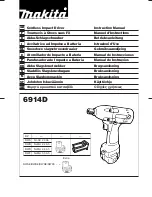
1239-306
20V MAX IMPACT DRIVER
16
2. Drill a pilot hole (1) through the outer piece (2) and into the inner piece (3). Drill hole
2/3 the diameter of the smooth portion of the screw shank.
NOTE:
If the wood is soft, drill the hole 2/3 the length of the screw. If the wood is hard,
drill the hole the full length of the screw.
3. Remove the clamp from the two pieces to be screwed together.
4. Enlarge the hole (1) in the outer piece (2) so it is the same size as the smooth portion
of the screw shank (Fig. 9).
5. If using a flat head screw, countersink the hole (4) so the head of the screw will be
flush with the surface when fully driven into place.
DRIVING SCREWS
When driving screws, care must be taken to use a bit that correctly fits the head of the
screw being driven. Make sure you use the largest bit size that will properly fit into the
be in good condition and not worn so they will drive screws without slipping out of the
screw head.
1. Select the correct screwdriver bit for the screw being driven and install it
in the collet (Fig. 4).
2. Set forward/reverse switch to "forward" (Fig. 5).
3. Insert the screwdriver bit fully into the screw head (Fig. 10).
4. While holding the screwdriver bit firmly against the screw and the bit aligned with
the screw, squeeze the trigger switch to start the cordless driver and drive the screw.
5. When the screw is driven to the correct depth, release the switch and the impact
driver will stop.
NOTE:
As the screw is driven into the wood, the torque required to completely drive the
screw into the wood will increase. The impact function will allow you to continue driving
the screw until it is fully nested in the countersunk area.
6. Release the trigger as soon as the screw is driven to the desired depth. Failure to
release the trigger at this point will result in an overdriven screw and possibly twist
the head off the screw.
Fig.10
NOTE:
To remove screws, follow the same general procedure as for driving screws.








































